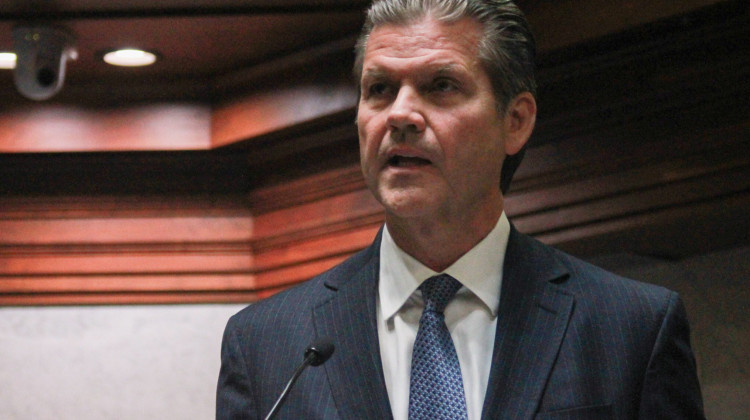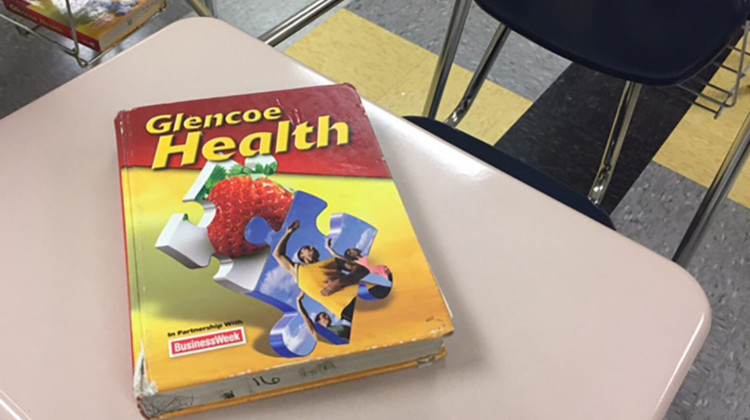
Students at Noblesville High School will start their school day a bit later next year, after administrators examined research showing sleep can positively impact teenage students' performance.
Rachel MorelloSleep more and sleep in – that’s the advice doctors are giving teenagers.
As we reported last week, a new recommendation from the American Academy of Pediatrics encourages middle and high schools to push back their start times to align students’ academic schedules with their biological sleep rhythms.
AAP research as well as a number of other studies shows that adolescents should ideally get between 8.5 and 9.5 hours of sleep each night. Recent polls show only 41 percent of middle schoolers and 13 percent of high school students do.
Even the U.S. Secretary for Education, Arne Duncan, has acknowledged older students’ need for more zzz’s, in an interview on "The Diane Rehm Show":
“Mornings are very difficult. You know, they’re not awake. They’re groggy. They’re not able to pay attention in class. If we were able to start later and if they were able to be more focused, if they were able to concentrate in class, that’s a really good thing. So often education, we design school systems that work for adults and not for kids. I think this is just another example of that.”
Some schools in Indiana are moving to adhere to these later start times; for others, it’s a distant dream.
WHAT DOES THE RESEARCH SAY?
Experts say that restful sleep can be a factor in a student’s performance as well as a number of other outcomes.
“The research is clear that adolescents who get enough sleep have a reduced risk of being overweight or suffering depression, are less likely to be involved in automobile accidents, and have better grades, higher standardized test scores and an overall better quality of life,” says Dr. Judith Owens, author of the AAP recommendation. “Studies have shown that delaying early school start times is one key factor that can help adolescents get the sleep they need to grow and learn.”
Dr. Vaughn Rickert, an adolescent medicine professor at the IU School of Medicine, agrees, adding that the brain develops at ‘incredible rates’ during the teenage years.
“Between the ages of 14 and 24, kids are at the highest risk for the emergence of mental health and psychiatric disorders, and sleepiness does contribute to that,” Rickert says. “Poor sleep [also] contributes to generally not being healthy, catching infections and colds and things like that.”
Rickert says the longer teens can sleep, the better the quality of that sleep will be.
“As you proceed with the sleep cycle, you spend more and more of your time in what we call REM sleep, which is Rapid Eye Movement sleep – that’s the sleep that really contributes to restfulness,” Rickert explains. “In the early morning hours, you’re spending anywhere from 40 to 60 minutes in REM sleep. So the longer that people sleep, the greater amount of time they spend in REM sleep, and you’re getting more restfulness.”
Owens and her fellow researchers call the various reasons for teens’ lack of sleep ‘complex,’ citing homework, extracurricular activities, after-school jobs and use of technology that can keep them up late on week nights.
NOBLESVILLE: SETTING THE BAR HIGH, AND THE ALARM LATER
Based on the research they’ve seen, administrators and board members with Noblesville Schools decided they will implement later start times across their middle and high schools starting in 2015-16 academic year.
“It makes sense for us to start our middle schoolers and high school students a little later,” says Marnie Cooke, a spokeswoman for the district.
Those students currently start their day at 7:35 a.m. Although the district has not yet finalized its new hours, the proposal on the table would set a start time of 8:45 a.m. Concurrently, district elementary schools will start earlier – switching from 8:40 a.m. to perhaps the proposed 8 a.m.
Through a community survey, district officials found that 70 percent of respondents saw no negative impact from making the change for high school students. For the most part, Cooke says teachers, staff and parents have been on board with the later start, but she says there are obviously going to be some concerns anytime you’re talking about disrupting someone’s routine.
“Some concerns included the need for them to make adjustments to their child care plans, scheduling after-school activities, concerns about not preparing students for life after high school,” Cooke lists.
The district could have implemented earlier start times this year. Cooke says administrators purposefully chose to wait in order to give the community time to start thinking about and preparing for how they can address some of those issues.
“There’s no way around the fact that it will be a disruption for some families to make these changes,” Cooke acknowledges. “We want to make sure that obviously when we do implement a change, that we’re maximizing the efficiency of how we’re doing that.”
EVANSVILLE-VANDERBURGH: TIME TRADEOFFS
It’s 7:35 a.m. when the bell rings at each of the nine high schools in the Evansville Vanderburgh School district. The start time here is nearly an hour earlier than what the American Pediatric Association recommends, and it’s ten minutes earlier than last year.
Superintendent David Smith says the push forward came as a sort of side effect of lengthening the school day for elementary students. When the district adjusted elementary start times, pickup times for middle and high school students had to be moved up.
Although parents have responded overwhelmingly positive to the change, Smith says people will naturally look as to how the switch impacts their individual family.
“I’ve joked a few times with my minister that the most controversial thing that I think any church does is change the time of worship, and I think I can kind of share your pain!” Smith chuckles.
Smith says although he thinks it would be a good idea to let high school students start later, logistically it’s just not possible. The district is not in a financial position to expand its bus fleet, and he worries about the area’s Career and Technical Center, which services 19 other high schools in five surrounding counties in addition to Evansville.
“I certainly think our start and end times can be tweaked somewhat,” Smith admits. “We’ll continue to process what we can do to have our high schools start later, but that’s a conversation that’s going to involve five counties, and about probably 40,000 students and several districts.”
Evansville, like other districts, can edit its own hours as long as they meet the state-mandated requirements – at least six hours of class time per day for students in grades 7 through 12, and five hours for anyone younger than that.
In the meantime, students will get to school at 7:30 a.m. — and hopefully, get to bed in enough time to have a productive day.
 DONATE
DONATE






 View More Articles
View More Articles


 Support WFYI. We can't do it without you.
Support WFYI. We can't do it without you.